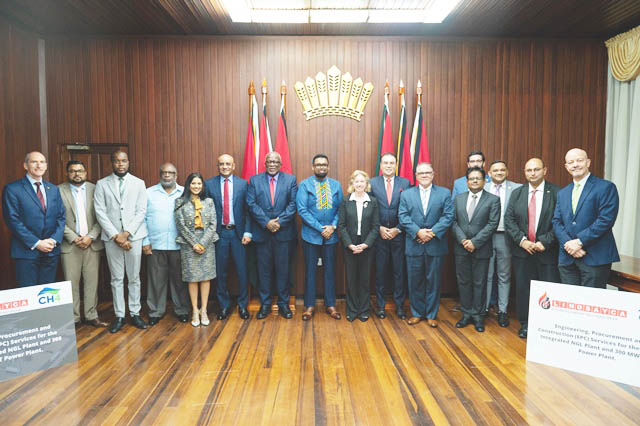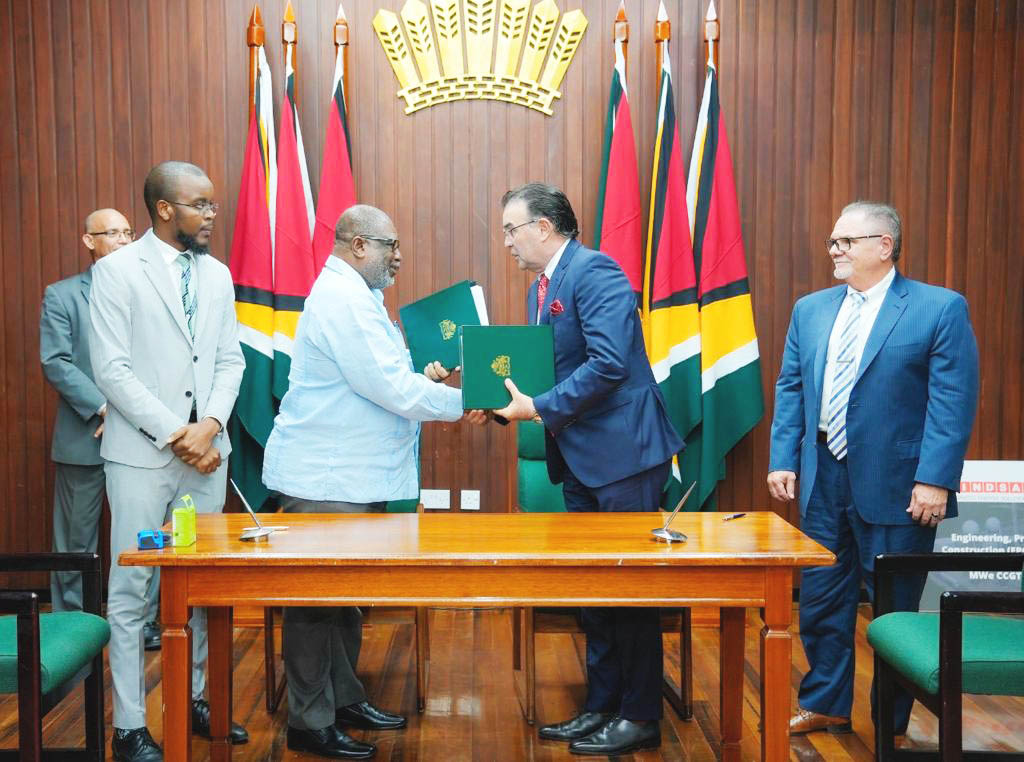In what will be the country’s most expensive public sector project ever, the contract to build the US$759 million, 300 MW combined-cycle power plant and a natural gas liquids (NGL) facility at Wales, West Bank Demerara (WCD), was yesterday inked between Guyana and US companies CH4/Lindsayca.
At the core of the project is a pledge by the government that power charges to householders and industry will be halved when energy is produced.
Signing of the contract came after months of concern that Guyana faces environmental and safety risks from this sprawling project and should not be locked into an enterprise that will burn fossil fuels for decades.

There are also concerns about whether Guyana will be able to absorb all of the energy produced and the wisdom of feeding power into a decrepit transmission and distribution system. The government has swept aside these concerns and is accelerating its plans for gas from offshore oil operations to be piped to the West Demerara shore and conveyed to Wales for this mega project.
At the signing yesterday, US Ambassador Sarah-Ann Lynch expressed optimism that it will serve to attract other investors from her country.
No one from the company spoke on the project that President Irfaan Ali described as the largest this country has ever invested in, but both he and Vice President Bharrat Jagdeo said that there will be a special meeting where the press will get technical explanations and could ask questions.
“I think the most exciting thing for me about this LINDSAYCA/CH4/Guyana relationship is that it will very likely unlock amazing opportunities for even more US businesses to look at Guyana as a destination for their investments,” the US envoy said during remarks at the signing which took place at the Office of the President yesterday morning.
Lynch recalled that she was asked by the Government of Guyana to bring quality US investors and businesses, of all sizes, to the country, which she said she did, as she reminded Ali of his words in Washington earlier this year, “We want to see more US involvement in this stage of our country’s development.”
She was later singled out by President Ali for being “a constant promoter of Guyana” in getting the US private sector aware of the opportunities that abound here and for her and the US embassy’s dedication for their work with this government.
Ali also thanked the US government for continuously and dependably being this country’s strong bilateral partner.
“I want to recognize the work. You have a responsibility for the US private sector, for US businesses and you have been executing your responsibilities as a team here,” Ali said as he reiterated his commitment to the project.
The president noted that the focus will now be on getting the project delivered on time, as he emphasized that while many may view it as only being able to serve as additional power, the potential spinoff benefits of the project are astounding.
“This project is not just about generation of power and liquids… understanding the opportunities this project will unlock for us as a country, is just enormous. From the liquids perspective, from energy and building our capacity on the energy side…” Ali said.
Lead negotiator on the project, Vice President Jagdeo, said that negotiations and the technical work were not easy, as he too thanked those who had direct input while explaining that the list is too long for persons to be singled out. He said that they had had a relatively short period to put together a complex project of that nature and it was why all members of the team had to be at it “all the time,” but, ultimately, the government is confident in the choice of CH4/Lindsayca to execute the project.
“It started off from a very simple decision of where we wanted to land the pipeline… we were committed along the entire path to see that this project be developed at the highest international standards; environmental; engineering; procurement, we even went beyond what was normally done,” Jagdeo explained.
Timelines
“Given the importance of this project we had to get this right and we believe that with this contractor… they will deliver on the project. Timelines are important for us, the quality of the work and staying within budget. These are the three things that we will look for and monitor carefully,” he stressed.
It was Jagdeo who last Friday announced that successful negotiations had resulted in a reduced cost, and that government was finalising the US$759 million contract with the company.
“…We are extremely pleased that this week we have finally wrapped these up… that the mobilization could be paid and that we are on the way to the construction of this facility that would transform Guyana in terms of stable power, in terms of cost of power,” Jagdeo had told a press conference.
The decision came roughly one month after President Ali announced that Cabinet had issued its no-objection to US-based CH4/Lindsayca being ranked number one to build the two plants under an Engineering Procurement Construction (EPC) contract.
Jagdeo had noted that the company’s initial US$898 million-bid made provision for a number of things not provided for as part of the manufacturer’s requirements, which were removed during negotiations.
“So those were removed, and based on the original scope of the contract, the bid price, the final price, came down to US$759 million,” he said.
The Vice President who also has oversight for the oil and gas and finance sector, mentioned that the requirement for this project to be completed by December 2024 was one of the key features that led to the selection of CH4/Lindsayca.
“It would allow us in two years’ time to reduce the power cost by 50 per cent. It would transform us from now an importer of cooking gas to an exporter of cooking gas and that facility will belong to the government of Guyana, not Exxon, the power plant and NGL facility,” he added, before saying that the contracts, including the supervision by Engineers India Limited, are to be finalised before yearend.
Exim Bank
Briefly addressing funding for the project, Jagdeo informed that there was over $20 billion already budgeted for the first payment “and then we are trying to structure this, maybe through a loan where we would be approaching Exim Bank US.”
Stabroek Block operator, ExxonMobil Guyana, is expected to deliver the completed gas pipeline to the Wales facility by the fourth quarter of 2024, to achieve commissioning and testing of the 300 MW power plant by the end of 2024.
On its website, the Texas-based Lindsayca says it was founded in 1995 through private equity and family ownership. Further, Lindsayca has rapidly expanded initially into Venezuela, providing services to both state- and privately-owned clients in the upstream and downstream energy sector.
Meanwhile, the CH4 Group describes itself as an “Engineering, Procurement, Construction (EPC), project management, operation and maintenance group of companies, with extensive experience in the areas of the electric power, oil, gas, petrochemical, mining and infrastructure.”
With the announcement of Lindsayca’s selection, local opposition party, the Alliance for Change, had questioned the company’s experience in delivering a project of such magnitude.
Jagdeo yesterday responded that the company currently has two contracts that are worth over US$1.1 billion combined as he dismissed the research done by the party.
In his announcement last month, Ali had said that the project is expected to deliver power at less than half of the current costs. “Project generation costs, taking account of payment for the pipeline, operations and maintenance [O&M], and capital cost recovery, shall total less than five (5) US cents per kilowatt-hour.”
Of the US4.5 cents per KWH that will be paid, he said it “includes paying back for the pipeline, the LGN, facility and the operational costs.”
Earlier this year, he noted that nine firms were publicly pre-qualified to bid on the EPC contract. A Request for Proposals (RFP) was issued to these pre-qualified bidders. At the closing date of September 13, five bids were received. These bids were evaluated for technical compliance and ranking by Stantec and Worley, two global engineering firms with expertise in oil and gas, the President said. Based on the reports of these international firms, an evaluation team of three persons, including a representative of ExxonMobil, was appointed. He assured that the evaluation team had conducted the evaluation in accordance with the technical and economic criteria set out in the RFP. On the basis of the bids submitted and clarifications received, the team unanimously ranked CH4/ Lindsayca as number one, and Power China as number two.
The project aims to employ approximately 800 workers during the peak construction stage and 40 full-time workers during the operation phase.
It will be executed in three phases – construction, operation and decommissioning. It entails three aspects as well – an offshore pipeline which is approximately 220 kilometres of a subsea pipeline extending from new subsea tie-ins at the Destiny and Unity FPSOs in the Stabroek Block, to the proposed shore landing located approximately 3.5 kilometres west of the mouth of the Demerara River; onshore pipeline that is a continuation of the offshore line and extends about 25 kilometres from the landing site to the NGL plant; and the NGL plant and associated infrastructure that will be located about 23 kilometres upstream from the mouth of the Demerara River on the west bank.
Both the Liza Destiny and Liza Unity floating production storage and offloading vessels, which are operating in the offshore Stabroek Block, have pre-installed facilities to allow for the export of the associated gas along with crude production.




